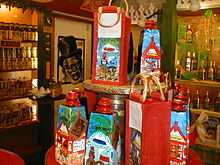Myrciaria floribunda
| Myrciaria floribunda | |
|---|---|
 | |
| Scientific classification | |
| Kingdom: | Plantae |
| (unranked): | Angiosperms |
| (unranked): | Eudicots |
| (unranked): | Rosids |
| Order: | Myrtales |
| Family: | Myrtaceae |
| Genus: | Myrciaria |
| Species: | M. floribunda |
| Binomial name | |
| Myrciaria floribunda Berg. | |
| Synonyms | |
|
Eugenia floribunda H. West ex Willd. | |
Myrciaria floribunda, guavaberry or rumberry is a fruit tree which grows in the Caribbean. The guavaberry, which should not be confused with the guava, is a close relative of camu camu.
Guavaberry trees or shrubs grow in a variety of shapes and sizes up to 60 feet high. They have red-brown branches and small pink and white flowers. The fruit, which are roughly half the size of cherries, are yellow-orange or dark-red with tanginess of a guava containing a small amount of translucent flesh surrounding a stone. Taste of the fruit has recognizable fair sweetness.
Guavaberry trees can be found growing wild in Central America, South America, Cuba, Dominican Republic, Haiti, Jamaica, Puerto Rico, and on many islands in the Lesser Antilles. The guavaberry has also been introduced to Florida, Hawaii, Bermuda, and the Philippines.

Guavaberry is used to make jams and drinks. Guavaberry liqueur, which is made from rum, is a common Christmas drink on many of the islands, particularly in Sint Maarten and the Virgin Islands. The colonists from Denmark and Holland found it could flavor rum by infusion similar to infused schnapps. In the Dominican Republic it is associated with the eastern town of San Pedro de Macorís which has a large population of Eastern Caribbean descent. Guavaberry is also used for medicinal purposes.